
Metal Gear: Retrospective
Steve
SNAKE! Dum dum dumdumdum dum dum dum!
If you don’t know what I mean, you probably wont want to follow me on this retrospective of one of the greatest series ever made.
Metal Gear games are a bizarre breed of game. Part stealth em up, yet you fight tanks and airplanes, and part action movie but you are constantly faced with reams of talking head exposition, part serious comment on nuclear war and part farcical self indulgent comedy.
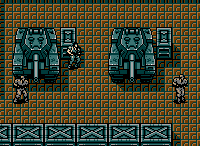
In my review of the series I’ve gone back to look at the first game from 1987 in order to try and discover where these idiosyncrasies came from, and I’ve been both surprised and amused at what I’ve found.
The first game was released in 1987 which I never played this on release. I hold my hands up. It’s only recently that I’ve gone back to look at the game, so I sort of missed the whole impact of it when it was first released.
Looking at it now you can’t help but be overawed at how much of it is still being used within the modern Metal Gear games. This game came out in 1987, I bet some of you weren’t even born then, that is how old this game is. The first thing that stuck me with this is that it has an excellent sense of place, it foreshadows Metal Gear Solid in that the first scene has Snake swimming out of a dock in order to infiltrate the base. From this blossoms a great story, which lets be truthful here, basically hasn’t changed in the more recent Metal Gear games.
It’s got all the things you’ll know and love, cardboard boxes, cigarettes, electric floors and remote controlled rockets, crazy bosses (even got a flamethrower boss eh..), Hind D fight and last but by no means least a Metal Gear. The game uses the same mechanics as all subsequent Metal Gear games, one action button for items and one for weapons, and has copious exposition given through codec messages. This game literally must have blown peoples socks off when it came out, so many new ideas and takes on how a game should play.
Although looking back on it now there are some really shocking gameplay elements, the guards only see in straight lines, if you’re stood next to one of them they will only see you if the actually turn to look at you, the codec discussions are room based, meaning if you go back to the a room you’ve previously visited you will get the same message as before, you can escape an alarm bell if you leave the screen………oh hang on.
This first story sets up so many plot strands for the later Metal Gear games that it’s hard not to play it now without a knowing smile on your face, you get to fight Big Boss! I mean for all the talking of Big Boss in the Metal Gear series you can’t help but wonder when playing the later games what he actually looked like and whether he was as hard as you imagine him to be, a crack black ops leader who went power mad and set up his Outer Heaven. Well I’ve killed him and now I know.
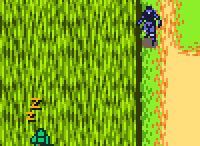
A bizarre game which doesn’t really fit into the main Metal Gear story arch. It’s more like a best of album from your favorite band. It’s got all the hits on there but doesn’t listen as good as previous albums. Technically if you were to draw time line it would sit after the first Metal Gear game, but the story seems anachronistic in that it brings in elements from Metal Gear Solid on the playstation to a period in time when they may or may not have been relevant. This is a good thing in that it brings some of the improvements from Metal Gear Solid to a game which uses them wisely, it’s got VR missions and also a series of bosses named after animals. Slash Hawk anyone? It was ok this game, it filled the time between the releases of Metal Gear Solid and Metal Gear Solid 2, but you couldn’t help but feel it was just a stepping stone. Also it had an unholy reliance on using the new colour screen of the GBC in a tedious series of colour based box and conveyor belt puzzles.
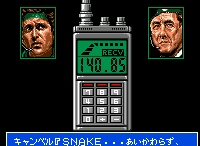
Due to the great reception of Metal Gear a sequel was commissioned and Snake’s Revenge was released in 1990 on the NES. However this game had no input from Hideo Kojima, and has subsequently been written out of the Metal Gear time line with his later games. Popular knowledge has it that Kojima didn’t know of the existence of Snakes Revenge until he was told of it while traveling on a train, at this time he was told that he should make a true sequel. And following on from this Metal Gear 2 : Solid Snake was released in 1990. Metal Gear 2 : Solid Snake was only released in Japan and on the MSX. It didn’t see a release in the West until Metal Gear Solid 3 : Subsistence in which it was included as an extra. So for many of us, including me, this game went totally unnoticed. Metal Gear 2 : Solid Snake had some major improvements over the original game and some of these improvements have carried forward for the more recent games.
There was now a radar system on the screen which showed your position and that of the baddies, this also got scrambled when you were seen and the guards went into alert phase, the alert phase now also having more than one variation, red, yellow and then normal infiltration. Remember these from Metal Gear Solid? The codec sections now showed the heads of both people who were talking and were situation specific rather than location specific as in the first game. The range of moves for Snake had also increased massively and he could now duck and crawl allowing for much more open and expansive environments. There were a series of maps each with various screens but each screen was linked and the guards were therefore able to patrol between the various screens. This was a massive leap and the gameplay benefited greatly from this, a much more consistent and believable universe was created and the game still plays well today. Due to this increased immersion the story benefited immeasurably, this was the first game in the series which had proper detailed codec conversations. And through this the story was allowed to progress apace.
This game also introduced many series stalwarts, anonymous codec helper (remember Deepthroat) , Master Miller, Roy Campbell and Gray Fox and discussed seriously for the first time consequences of war and nuclear armament. From this point forward the series would always comment on the futility and morality of war and nuclear weapons. In fact this game includes so many aspects from Metal Gear Solid that many people have come to look upon Metal Gear Solid as a kind of pseudo remake of this game. Both games have Snake coming out of retirement to do one more mission, both include a double cross (yeah again), a kidnapped scientist, a spiral tower building with guards chasing you and a lift encounter with invisible guards. The Metal Gear series as we know it today was truly born.
It’s actually something to go back and play it as it feels so like the later Metal Gear Solid games that it’s unnerving, including all the tedious backtracking and the meta references to the fact you are playing a game like having to look in the booklet for new frequencies.
Oh and while I’m talking about plot strands, remember the famous fight between Gray Fox and Snake which is referenced in Metal Gear Solid? Yeah I’ve done it. In a room full of mines and using just my fists.
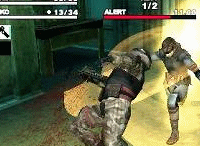
Bizarrely, and for no apparent reason, this is a turn based strategy game, and not a very good one at that. Well ok… it was alright. It used a similar view point and graphical style to the Metal Gear Solid games and still had many of the series hallmarks and items, however the major departure for this game was the use of a card based battle system. This worked like most other card based strategy games in that you had a deck of cards to make your attacks and moves.
This was an early release on the PSP and as such had garnered a fair bit of pre-launch hype, however upon the realisation that it was a turn based card strategy game many traditional fans turned away from it and were disappointed. It was a very brave move from Konami and not only showed their support of a as yet unproven platform, but also showed how they were constantly thinking outside the norm with what to do with the Metal Gear series, not just with the turn based system but also with the brave cell shading used in the story elements, an aspect the sequel took even further. This did well enough at retail that a sequel was commissioned and Metal Gear AC!D 2 was released the following year.
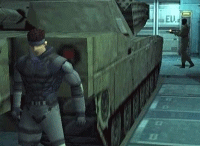
And then we turn to Metal Gear : Solid a game which for many of us will represent the first time we ever played the series. Lets cut to the chase here, this game was phenomenal and came out at the best possible time when the PS1 was dominating the world and Sony couldn’t do anything wrong. I remember when this game was coming out there was a huge amount of hype building for it and by the time of the actual release anticipation was running at fever pitch.
For the first time the game was given the moniker Tactical Espionage Action, and that has stuck with the series ever since. The game had an amazing introduction and far outpaced any other game currently on the market for generating a sense you were watching and playing in an action movie, with the game actually starting and allowing you to get past the first obstacle before the title appeared on the screen in a blaze of glory while Snake ripped off his diving mask.
As I said previously many people looked upon this as a port or retelling of Metal Gear : Solid Snake, and whilst this does share some story elements it’s definitely a third game in the storyline. And given the new medium of CD this story was able to be told with far more involving codec moments, using voices for the first time,which lent a particular emotional depth to the characters.
And what new characters! This game introduced us to the Cyborg Ninja, Liquid Snake, Otacon, Merly and Revolver Ocelot, all of whom are recurring characters in the later games. This game also had some audacious bosses, we all know and love Vulcan Raven and how he used to slowly destroy the scenery during your battle making a constantly shifting environment in which you fought, Sniper Wolf and how you could just hide from round the corner from her and use Nikitas to kill her, and last but no means least Psycho Mantis who could read your mind, unless that was you used controller port 2!
The extra space of the CD also allowed for video clips to be integrated within some of the cutscenes, which Kojima used to further emphasize story and in turn his views on the nature of war and especially nuclear war. In fact disc 2 was comprised largely of video footage. He also used the extra space to put on mission recaps of the previous games in which you got to read through iterative menus and discover the plot of the earlier games yourself.
This game wasn’t shy from using mature and often violent scenes, and in fact it was subject to some editing when it reached our shores. Does anyone remember seeing Gray Fox’s head get squashed by the Metal Gear, the Japanese version showed it but for us the camera cut away. There was also cutting of parts of the scene in the corridor with the Ninja when he slaughters the squad of soldiers. All this at a time when people still though mature games should involve Lara Croft in catsuit. This game was amazing and started a whole generation of people on to the Metal Gear series.
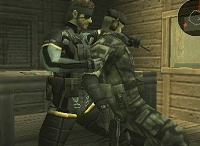
Released again for the PSP, this was the first PSP title to retain the action elements from the main Metal Gear games. It was a direct sequel to Snake Eater and followed the story of Big Boss, sorry Naked Snake, and his attempts to clear his name avert a nuclear war and recruit a crack squad of his very own which he goes on to call FOX Hound.
It involved cardboard boxes, Roy Campbell, David Hayter and Ocelot. In the game you controlled a squad of people and had to clear maps and kill or subdue enemies, subdued enemies could be recruited to your squad and used in future missions. This gameplay foreshadows the future online game Metal Gear Online which is to be released with Metal Gear Solid 4, it starts to show the new hud system which allows you to identify local enemies and has a strong team based element. This online element was further expanded on in the sequel called Portable Ops Plus which focused much more on online play.
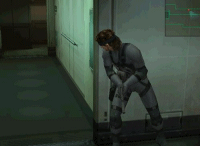
It was inevitably never going to be as good as Metal Gear Solid, I mean how do you follow up on perfection? I don’t know, but I do know what you shouldn’t do. You shouldn’t replace the main beloved protagonist for a pale haired young androgynous upstart who does cart wheels instead of forward rolls! I make no qualms about saying this game was a let down on many fronts.
The story, although always bizarre, took a unprecedented turn for the surreal in this game and lost a lot of it’s clarity. I’ll be jiggered if anyone can explain to me in a sentence what or who the Patriots are. The gameplay suffered through the removal of Snake, there is no more harsh a way to punish players then to tease them with a next generation version of Snake, only to remove the use of him after only 30 minutes of gameplay.
The opening tanker level was amazing, it had a massively cinematic opening on the bridge with fantastic rain effects and a climatic tense section crawling around countless troops and the new Metal Gear. Brilliant! On the other hand the main game placed you on an identikit rig and had a boss in it who was a crazy fat bomber whos favorite method of transport was inline skates and who enjoyed wearing body armour up to his head….no hang on the Fatman was a stoke of genius.
Although I’ve spent the last paragraph berating this game, I still hold a soft spot in my heart for this. The new gameplay elements introduced were great, there was now a proper first person aiming mode which you could use to hold up guards and you could further use this view to shoot their radios to stop them calling in for backup, or you could just point at their crotch and make them shake. This game also used the analogue buttons on the pad to great effect, allowing you to draw your gun quickly or silently. This also started to flesh out the roll of Ocelot and had an audacious plot conceit which effectively resurrected Liquid Snake through a grafted hand.
The ending also needs special note as the battle against the army of Metal Gears was just stunning and was followed up by a great cutscene. In fact the cutscenes in this game were of a level never before seen, both in quantity and quality. They really added a depth to all the characters and showcased a great cinematic flair from Kojima. It was the first Metal Gear game on the next generation of console and carried an unbelievable amount of expectations on it’s shoulders.
We all remember the multiple trailers at E3 (you remember E3?) drawing huge crowds of excitable journalists, and Konami’s self promoting step of including a demo of the Tanker level of the game with Zone of the Enders. For all it’s flaws this game succeeded in bringing the franchise up-to-date and blew all the other stealth-em-up clones released since Metal Gear Solid out of the water. So successful was this game in fact that it was ported over to the Xbox, suffering from some appalling slowdown, and Pc. This game also spawned an enhanced Substance version which included additional VR missions and a skateboarding Snake!
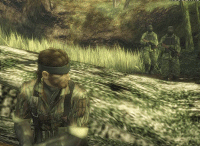
The last game in the Metal Gear cannon on the PS2 had a cheeky streak to it. From the tongue in cheek reference to Halo in the opening cutscene through to the boss you could beat by changing the PS2 clock and letting him age to death. But the most ballsy thing about this game was that it still didn’t let you play as the Snake we know and love. Yes he may have looked, sounded, acted and moved like Solid Snake but he was in fact the character we know as Big Boss.
Think about this for a minute, we haven’t played as Solid Snake since 1999! Regardless this game was still a great piece of fan service, it was set as a prequel in the 1960’s during the cold war and as such was able to tell a lot of the backstory to the Metal Gear series. It touched on the genesis of the Metal Gear weapon, it explained the origins of Ocelot and covered off how Fox Hound was created.
The gameplay had also evolved once again this time introducing a more organic world to contrast with the previous games sterile bases. This game tasked you with sneaking through a living breathing jungle and made you hunt to maintain your health. You could now climbs trees and, yes, eat snakes. The game also introduced a drastically new camouflage mechanic. This allowed you to mix and match your face paint and your clothes to create a new camouflage scheme to blend into the various locations. This mechanic can clearly be seen as the origins to the new optic camo in Metal Gear Solid 4.
However all these new gameplay elements were almost ruined by the bane of many third person action games, a poor camera. The camera was too close and just wasn’t adjustable enough to give you a full view of the area you needed to sneak past, which when you consider this game was all about the identification of enemies and sneaking past them, almost broke the game. This was later remedied in the subsequent release of a Subsistence which, like Substance, was like a directors cut. Subsistence had extra mission modes, an emulation of the first two Metal Gear games and a fully fledged online mode.
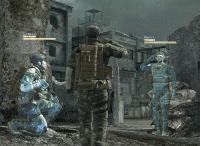
This game plans to redefine what Metal Gear is about. It turns what was a stealth action game into a team based online deathmatch. But don’t get all worried, I’ve played the Beta and it’s not all Quake guns and glory, or all Team Fortress role specific.
Instead this uses the same engine as Metal Gear 4 and is therefore viewed from a thirdperson perspective and It’s much more tactically focused than most other online death matches I’ve played. In this game you have a comms system which gives you constant feedback onto the position of the rest of your team and the use of this is key to winning a match, as your opponents can hack into this system and gain an advantage.
It is very much an evolution to the PSP game Portable ops, but from what I played in the Beta it just doesn’t gel. This game is to be bundled with Metal Gear 4 and, one can only assume, is an attempt for the PS3 to broaden it’s current online options, which considering the PS3 still lying in the wake of the 360’s dominant online presence, is no bad thing.
All the Metal Gear games differ in their gameplay, setting, mood and character yet they all share one common trait. They are all identifiably Metal Gear. No other game series can mix real world politics, anti-nuclear messages, monkeys and invisible cyborg ninjas quite like Metal Gear can, and for that I salute them.
